Analysis of Employment Law: Peter's Case and Legal Implications
VerifiedAdded on 2023/01/06
|7
|1946
|74
Report
AI Summary
This report provides an analysis of an employment law case concerning Peter, evaluating his employment status as either an independent contractor or an employee of a club. The analysis considers the working instructions, control, and financial arrangements to determine the nature of the employment relationship. The report then examines Peter's rights, obligations, and any breaches of implied duties under common law and the Fair Work Act 2009 (Cth). It identifies breaches of loyalty, good faith, and confidentiality, concluding that Peter's actions, including starting a competing business and making disparaging remarks, constituted significant violations of his employment duties. The report highlights the legal consequences Peter may face for his actions, emphasizing the employer's right to take legal action.
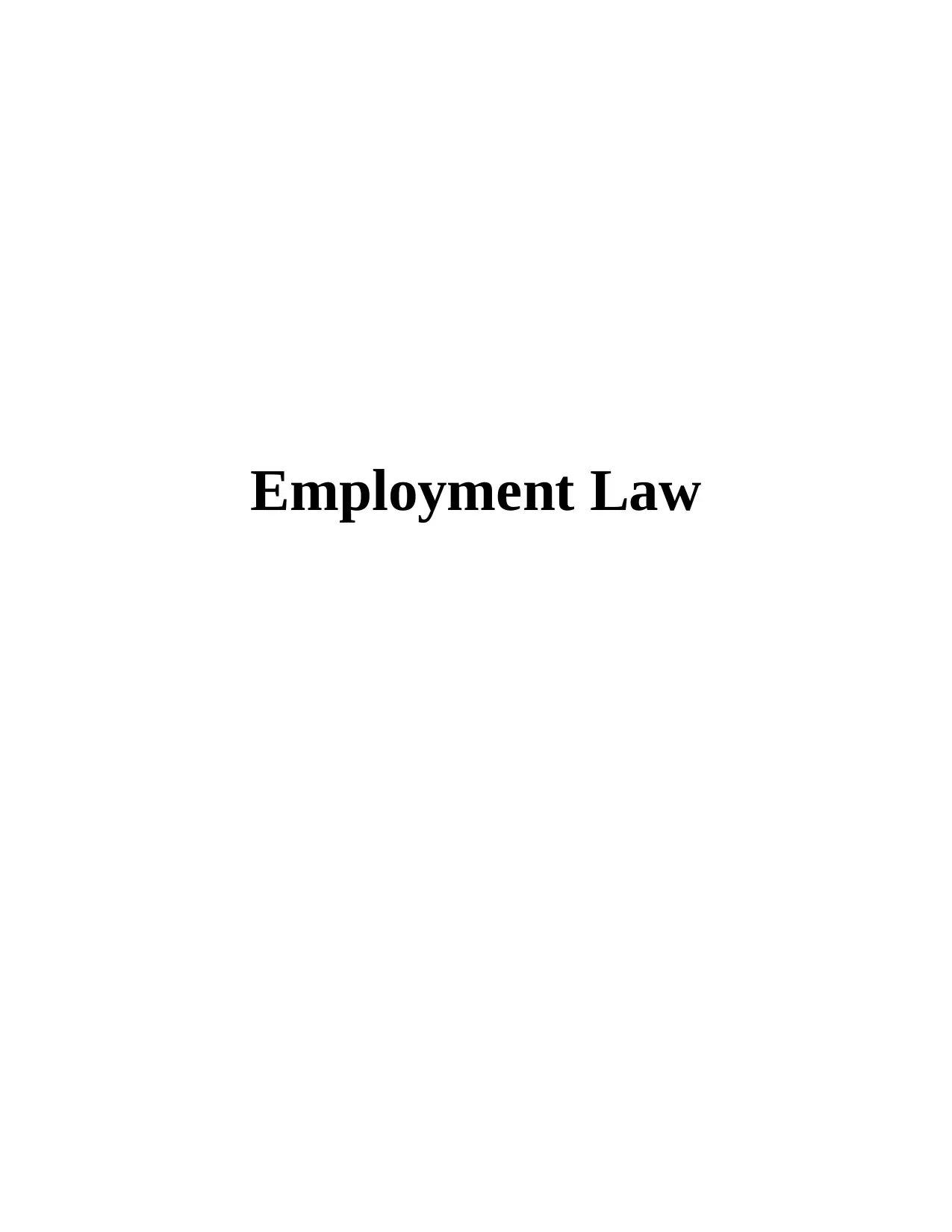
Employment Law
Paraphrase This Document
Need a fresh take? Get an instant paraphrase of this document with our AI Paraphraser
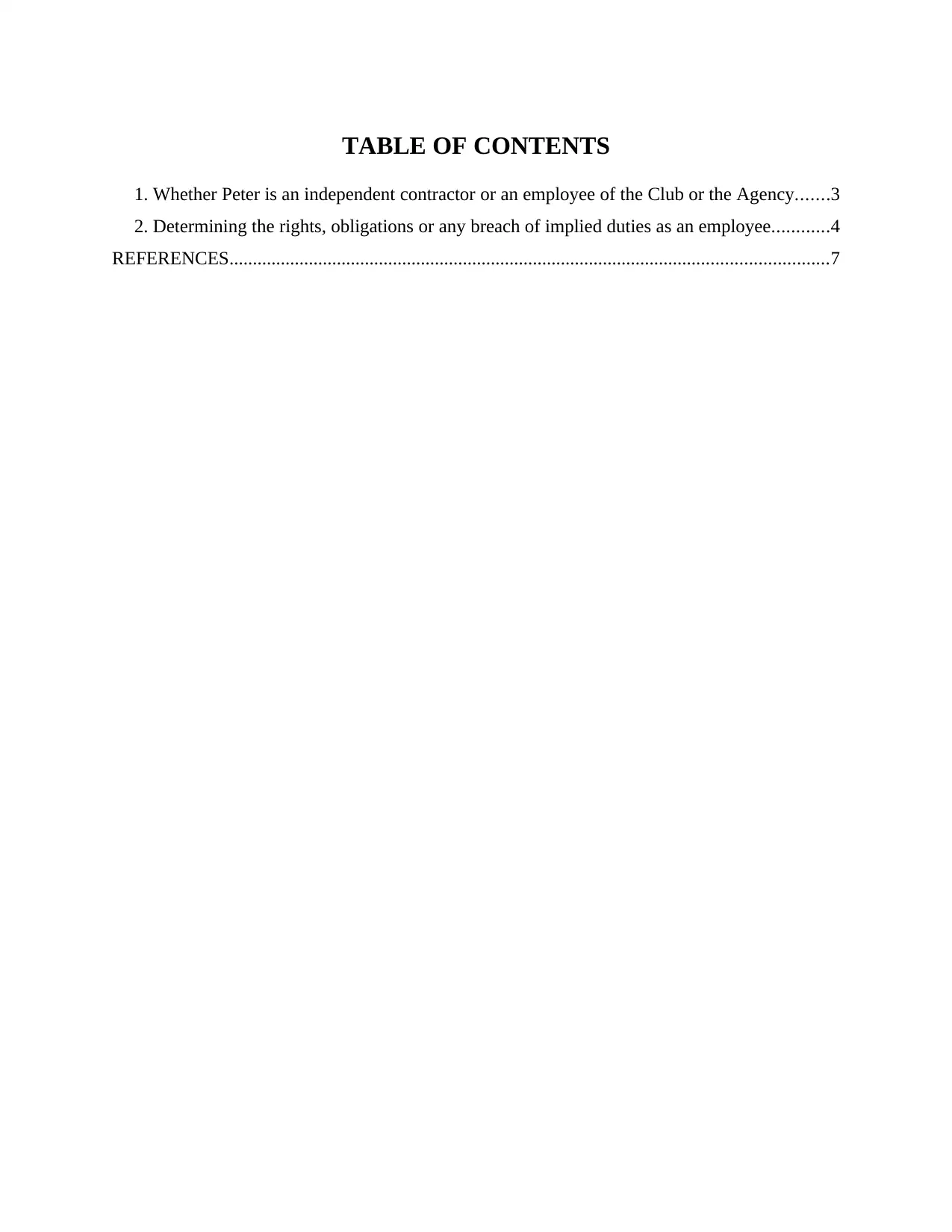
TABLE OF CONTENTS
1. Whether Peter is an independent contractor or an employee of the Club or the Agency.......3
2. Determining the rights, obligations or any breach of implied duties as an employee............4
REFERENCES................................................................................................................................7
1. Whether Peter is an independent contractor or an employee of the Club or the Agency.......3
2. Determining the rights, obligations or any breach of implied duties as an employee............4
REFERENCES................................................................................................................................7
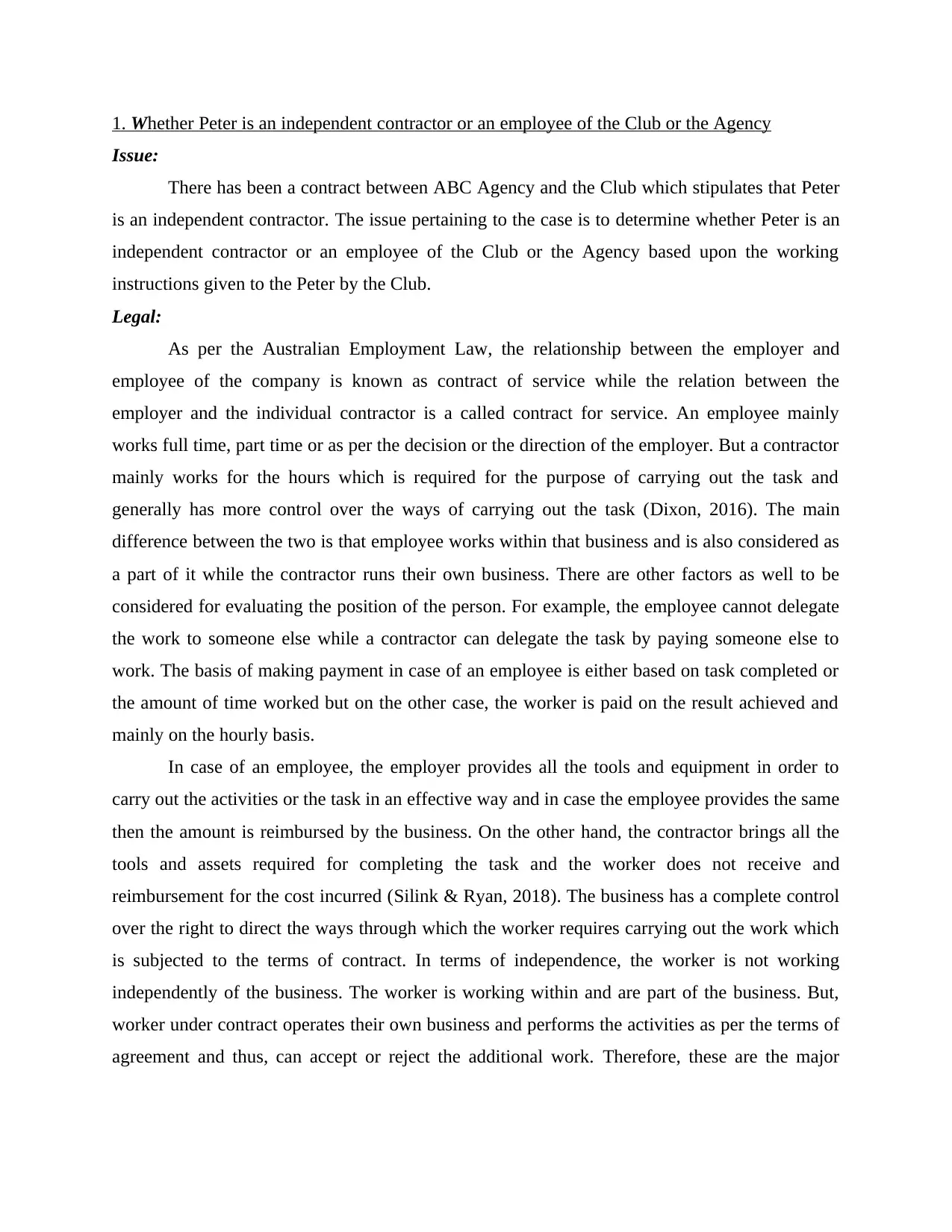
1. Whether Peter is an independent contractor or an employee of the Club or the Agency
Issue:
There has been a contract between ABC Agency and the Club which stipulates that Peter
is an independent contractor. The issue pertaining to the case is to determine whether Peter is an
independent contractor or an employee of the Club or the Agency based upon the working
instructions given to the Peter by the Club.
Legal:
As per the Australian Employment Law, the relationship between the employer and
employee of the company is known as contract of service while the relation between the
employer and the individual contractor is a called contract for service. An employee mainly
works full time, part time or as per the decision or the direction of the employer. But a contractor
mainly works for the hours which is required for the purpose of carrying out the task and
generally has more control over the ways of carrying out the task (Dixon, 2016). The main
difference between the two is that employee works within that business and is also considered as
a part of it while the contractor runs their own business. There are other factors as well to be
considered for evaluating the position of the person. For example, the employee cannot delegate
the work to someone else while a contractor can delegate the task by paying someone else to
work. The basis of making payment in case of an employee is either based on task completed or
the amount of time worked but on the other case, the worker is paid on the result achieved and
mainly on the hourly basis.
In case of an employee, the employer provides all the tools and equipment in order to
carry out the activities or the task in an effective way and in case the employee provides the same
then the amount is reimbursed by the business. On the other hand, the contractor brings all the
tools and assets required for completing the task and the worker does not receive and
reimbursement for the cost incurred (Silink & Ryan, 2018). The business has a complete control
over the right to direct the ways through which the worker requires carrying out the work which
is subjected to the terms of contract. In terms of independence, the worker is not working
independently of the business. The worker is working within and are part of the business. But,
worker under contract operates their own business and performs the activities as per the terms of
agreement and thus, can accept or reject the additional work. Therefore, these are the major
Issue:
There has been a contract between ABC Agency and the Club which stipulates that Peter
is an independent contractor. The issue pertaining to the case is to determine whether Peter is an
independent contractor or an employee of the Club or the Agency based upon the working
instructions given to the Peter by the Club.
Legal:
As per the Australian Employment Law, the relationship between the employer and
employee of the company is known as contract of service while the relation between the
employer and the individual contractor is a called contract for service. An employee mainly
works full time, part time or as per the decision or the direction of the employer. But a contractor
mainly works for the hours which is required for the purpose of carrying out the task and
generally has more control over the ways of carrying out the task (Dixon, 2016). The main
difference between the two is that employee works within that business and is also considered as
a part of it while the contractor runs their own business. There are other factors as well to be
considered for evaluating the position of the person. For example, the employee cannot delegate
the work to someone else while a contractor can delegate the task by paying someone else to
work. The basis of making payment in case of an employee is either based on task completed or
the amount of time worked but on the other case, the worker is paid on the result achieved and
mainly on the hourly basis.
In case of an employee, the employer provides all the tools and equipment in order to
carry out the activities or the task in an effective way and in case the employee provides the same
then the amount is reimbursed by the business. On the other hand, the contractor brings all the
tools and assets required for completing the task and the worker does not receive and
reimbursement for the cost incurred (Silink & Ryan, 2018). The business has a complete control
over the right to direct the ways through which the worker requires carrying out the work which
is subjected to the terms of contract. In terms of independence, the worker is not working
independently of the business. The worker is working within and are part of the business. But,
worker under contract operates their own business and performs the activities as per the terms of
agreement and thus, can accept or reject the additional work. Therefore, these are the major
⊘ This is a preview!⊘
Do you want full access?
Subscribe today to unlock all pages.

Trusted by 1+ million students worldwide
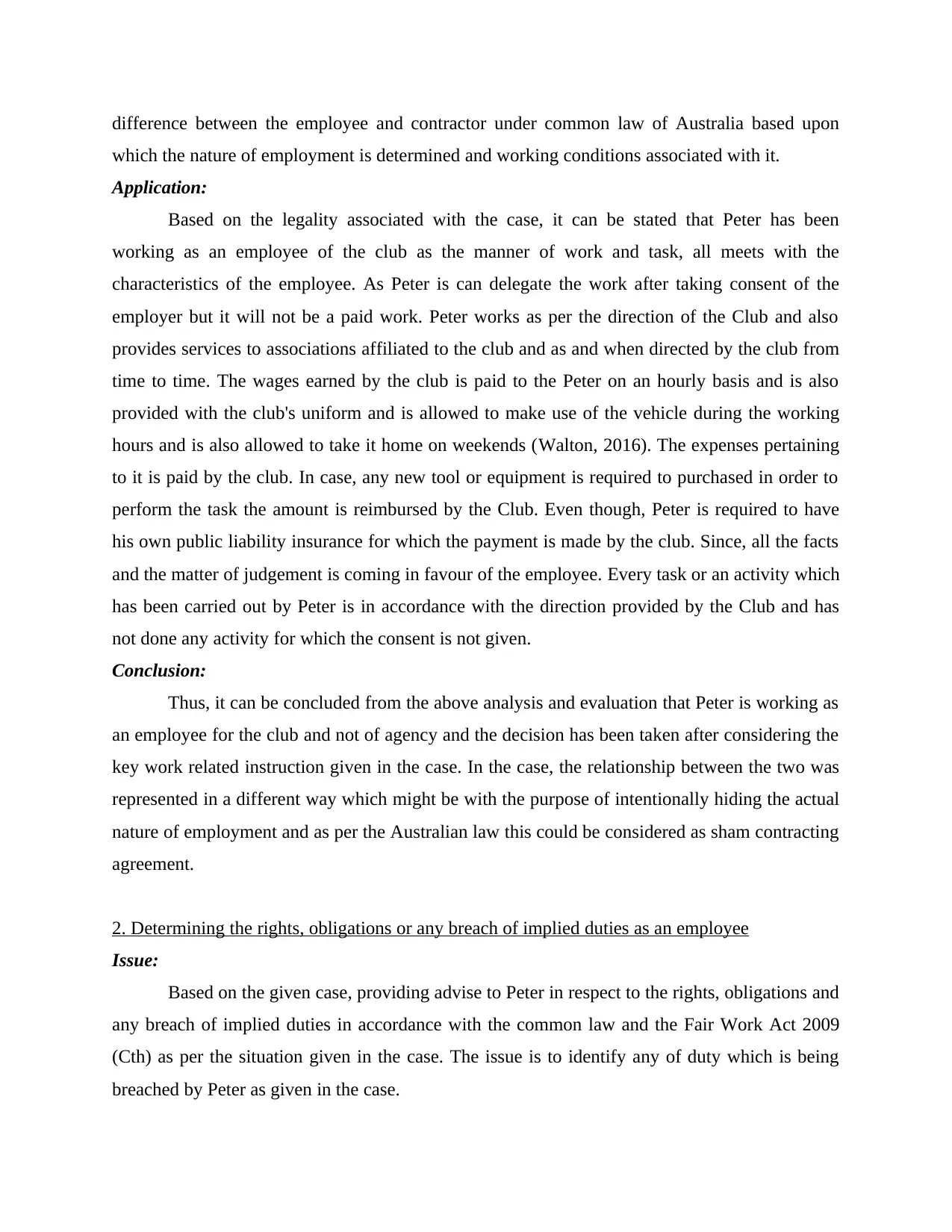
difference between the employee and contractor under common law of Australia based upon
which the nature of employment is determined and working conditions associated with it.
Application:
Based on the legality associated with the case, it can be stated that Peter has been
working as an employee of the club as the manner of work and task, all meets with the
characteristics of the employee. As Peter is can delegate the work after taking consent of the
employer but it will not be a paid work. Peter works as per the direction of the Club and also
provides services to associations affiliated to the club and as and when directed by the club from
time to time. The wages earned by the club is paid to the Peter on an hourly basis and is also
provided with the club's uniform and is allowed to make use of the vehicle during the working
hours and is also allowed to take it home on weekends (Walton, 2016). The expenses pertaining
to it is paid by the club. In case, any new tool or equipment is required to purchased in order to
perform the task the amount is reimbursed by the Club. Even though, Peter is required to have
his own public liability insurance for which the payment is made by the club. Since, all the facts
and the matter of judgement is coming in favour of the employee. Every task or an activity which
has been carried out by Peter is in accordance with the direction provided by the Club and has
not done any activity for which the consent is not given.
Conclusion:
Thus, it can be concluded from the above analysis and evaluation that Peter is working as
an employee for the club and not of agency and the decision has been taken after considering the
key work related instruction given in the case. In the case, the relationship between the two was
represented in a different way which might be with the purpose of intentionally hiding the actual
nature of employment and as per the Australian law this could be considered as sham contracting
agreement.
2. Determining the rights, obligations or any breach of implied duties as an employee
Issue:
Based on the given case, providing advise to Peter in respect to the rights, obligations and
any breach of implied duties in accordance with the common law and the Fair Work Act 2009
(Cth) as per the situation given in the case. The issue is to identify any of duty which is being
breached by Peter as given in the case.
which the nature of employment is determined and working conditions associated with it.
Application:
Based on the legality associated with the case, it can be stated that Peter has been
working as an employee of the club as the manner of work and task, all meets with the
characteristics of the employee. As Peter is can delegate the work after taking consent of the
employer but it will not be a paid work. Peter works as per the direction of the Club and also
provides services to associations affiliated to the club and as and when directed by the club from
time to time. The wages earned by the club is paid to the Peter on an hourly basis and is also
provided with the club's uniform and is allowed to make use of the vehicle during the working
hours and is also allowed to take it home on weekends (Walton, 2016). The expenses pertaining
to it is paid by the club. In case, any new tool or equipment is required to purchased in order to
perform the task the amount is reimbursed by the Club. Even though, Peter is required to have
his own public liability insurance for which the payment is made by the club. Since, all the facts
and the matter of judgement is coming in favour of the employee. Every task or an activity which
has been carried out by Peter is in accordance with the direction provided by the Club and has
not done any activity for which the consent is not given.
Conclusion:
Thus, it can be concluded from the above analysis and evaluation that Peter is working as
an employee for the club and not of agency and the decision has been taken after considering the
key work related instruction given in the case. In the case, the relationship between the two was
represented in a different way which might be with the purpose of intentionally hiding the actual
nature of employment and as per the Australian law this could be considered as sham contracting
agreement.
2. Determining the rights, obligations or any breach of implied duties as an employee
Issue:
Based on the given case, providing advise to Peter in respect to the rights, obligations and
any breach of implied duties in accordance with the common law and the Fair Work Act 2009
(Cth) as per the situation given in the case. The issue is to identify any of duty which is being
breached by Peter as given in the case.
Paraphrase This Document
Need a fresh take? Get an instant paraphrase of this document with our AI Paraphraser
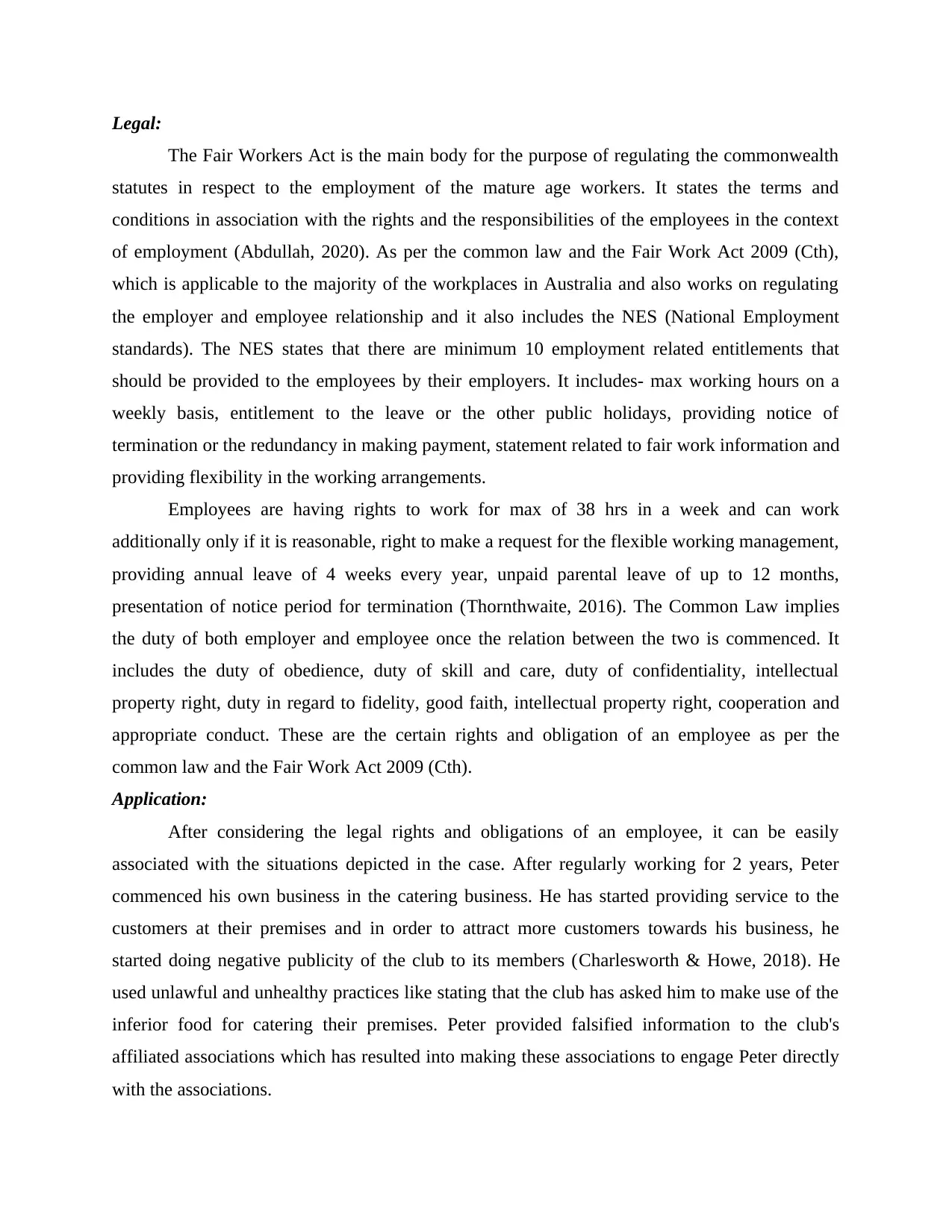
Legal:
The Fair Workers Act is the main body for the purpose of regulating the commonwealth
statutes in respect to the employment of the mature age workers. It states the terms and
conditions in association with the rights and the responsibilities of the employees in the context
of employment (Abdullah, 2020). As per the common law and the Fair Work Act 2009 (Cth),
which is applicable to the majority of the workplaces in Australia and also works on regulating
the employer and employee relationship and it also includes the NES (National Employment
standards). The NES states that there are minimum 10 employment related entitlements that
should be provided to the employees by their employers. It includes- max working hours on a
weekly basis, entitlement to the leave or the other public holidays, providing notice of
termination or the redundancy in making payment, statement related to fair work information and
providing flexibility in the working arrangements.
Employees are having rights to work for max of 38 hrs in a week and can work
additionally only if it is reasonable, right to make a request for the flexible working management,
providing annual leave of 4 weeks every year, unpaid parental leave of up to 12 months,
presentation of notice period for termination (Thornthwaite, 2016). The Common Law implies
the duty of both employer and employee once the relation between the two is commenced. It
includes the duty of obedience, duty of skill and care, duty of confidentiality, intellectual
property right, duty in regard to fidelity, good faith, intellectual property right, cooperation and
appropriate conduct. These are the certain rights and obligation of an employee as per the
common law and the Fair Work Act 2009 (Cth).
Application:
After considering the legal rights and obligations of an employee, it can be easily
associated with the situations depicted in the case. After regularly working for 2 years, Peter
commenced his own business in the catering business. He has started providing service to the
customers at their premises and in order to attract more customers towards his business, he
started doing negative publicity of the club to its members (Charlesworth & Howe, 2018). He
used unlawful and unhealthy practices like stating that the club has asked him to make use of the
inferior food for catering their premises. Peter provided falsified information to the club's
affiliated associations which has resulted into making these associations to engage Peter directly
with the associations.
The Fair Workers Act is the main body for the purpose of regulating the commonwealth
statutes in respect to the employment of the mature age workers. It states the terms and
conditions in association with the rights and the responsibilities of the employees in the context
of employment (Abdullah, 2020). As per the common law and the Fair Work Act 2009 (Cth),
which is applicable to the majority of the workplaces in Australia and also works on regulating
the employer and employee relationship and it also includes the NES (National Employment
standards). The NES states that there are minimum 10 employment related entitlements that
should be provided to the employees by their employers. It includes- max working hours on a
weekly basis, entitlement to the leave or the other public holidays, providing notice of
termination or the redundancy in making payment, statement related to fair work information and
providing flexibility in the working arrangements.
Employees are having rights to work for max of 38 hrs in a week and can work
additionally only if it is reasonable, right to make a request for the flexible working management,
providing annual leave of 4 weeks every year, unpaid parental leave of up to 12 months,
presentation of notice period for termination (Thornthwaite, 2016). The Common Law implies
the duty of both employer and employee once the relation between the two is commenced. It
includes the duty of obedience, duty of skill and care, duty of confidentiality, intellectual
property right, duty in regard to fidelity, good faith, intellectual property right, cooperation and
appropriate conduct. These are the certain rights and obligation of an employee as per the
common law and the Fair Work Act 2009 (Cth).
Application:
After considering the legal rights and obligations of an employee, it can be easily
associated with the situations depicted in the case. After regularly working for 2 years, Peter
commenced his own business in the catering business. He has started providing service to the
customers at their premises and in order to attract more customers towards his business, he
started doing negative publicity of the club to its members (Charlesworth & Howe, 2018). He
used unlawful and unhealthy practices like stating that the club has asked him to make use of the
inferior food for catering their premises. Peter provided falsified information to the club's
affiliated associations which has resulted into making these associations to engage Peter directly
with the associations.
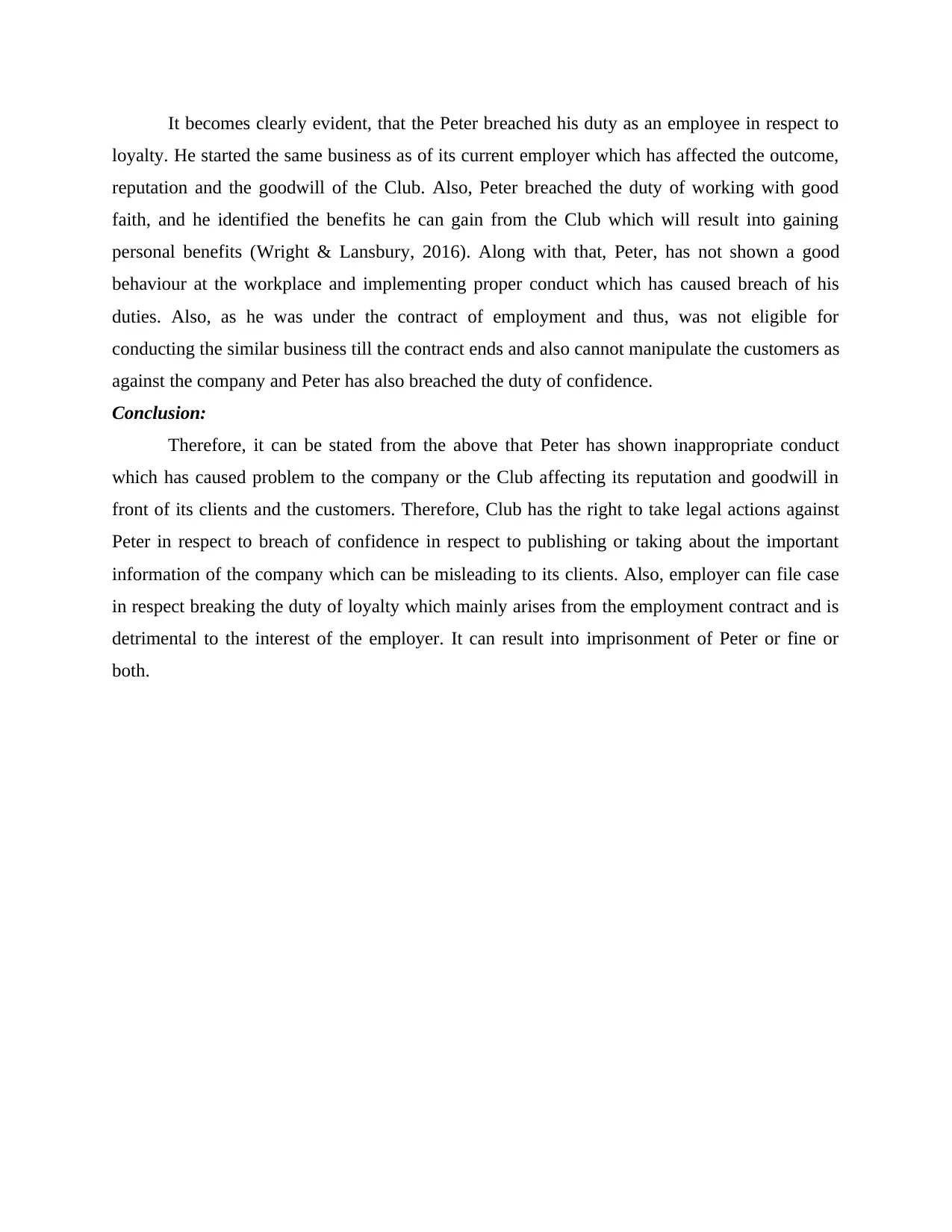
It becomes clearly evident, that the Peter breached his duty as an employee in respect to
loyalty. He started the same business as of its current employer which has affected the outcome,
reputation and the goodwill of the Club. Also, Peter breached the duty of working with good
faith, and he identified the benefits he can gain from the Club which will result into gaining
personal benefits (Wright & Lansbury, 2016). Along with that, Peter, has not shown a good
behaviour at the workplace and implementing proper conduct which has caused breach of his
duties. Also, as he was under the contract of employment and thus, was not eligible for
conducting the similar business till the contract ends and also cannot manipulate the customers as
against the company and Peter has also breached the duty of confidence.
Conclusion:
Therefore, it can be stated from the above that Peter has shown inappropriate conduct
which has caused problem to the company or the Club affecting its reputation and goodwill in
front of its clients and the customers. Therefore, Club has the right to take legal actions against
Peter in respect to breach of confidence in respect to publishing or taking about the important
information of the company which can be misleading to its clients. Also, employer can file case
in respect breaking the duty of loyalty which mainly arises from the employment contract and is
detrimental to the interest of the employer. It can result into imprisonment of Peter or fine or
both.
loyalty. He started the same business as of its current employer which has affected the outcome,
reputation and the goodwill of the Club. Also, Peter breached the duty of working with good
faith, and he identified the benefits he can gain from the Club which will result into gaining
personal benefits (Wright & Lansbury, 2016). Along with that, Peter, has not shown a good
behaviour at the workplace and implementing proper conduct which has caused breach of his
duties. Also, as he was under the contract of employment and thus, was not eligible for
conducting the similar business till the contract ends and also cannot manipulate the customers as
against the company and Peter has also breached the duty of confidence.
Conclusion:
Therefore, it can be stated from the above that Peter has shown inappropriate conduct
which has caused problem to the company or the Club affecting its reputation and goodwill in
front of its clients and the customers. Therefore, Club has the right to take legal actions against
Peter in respect to breach of confidence in respect to publishing or taking about the important
information of the company which can be misleading to its clients. Also, employer can file case
in respect breaking the duty of loyalty which mainly arises from the employment contract and is
detrimental to the interest of the employer. It can result into imprisonment of Peter or fine or
both.
⊘ This is a preview!⊘
Do you want full access?
Subscribe today to unlock all pages.

Trusted by 1+ million students worldwide
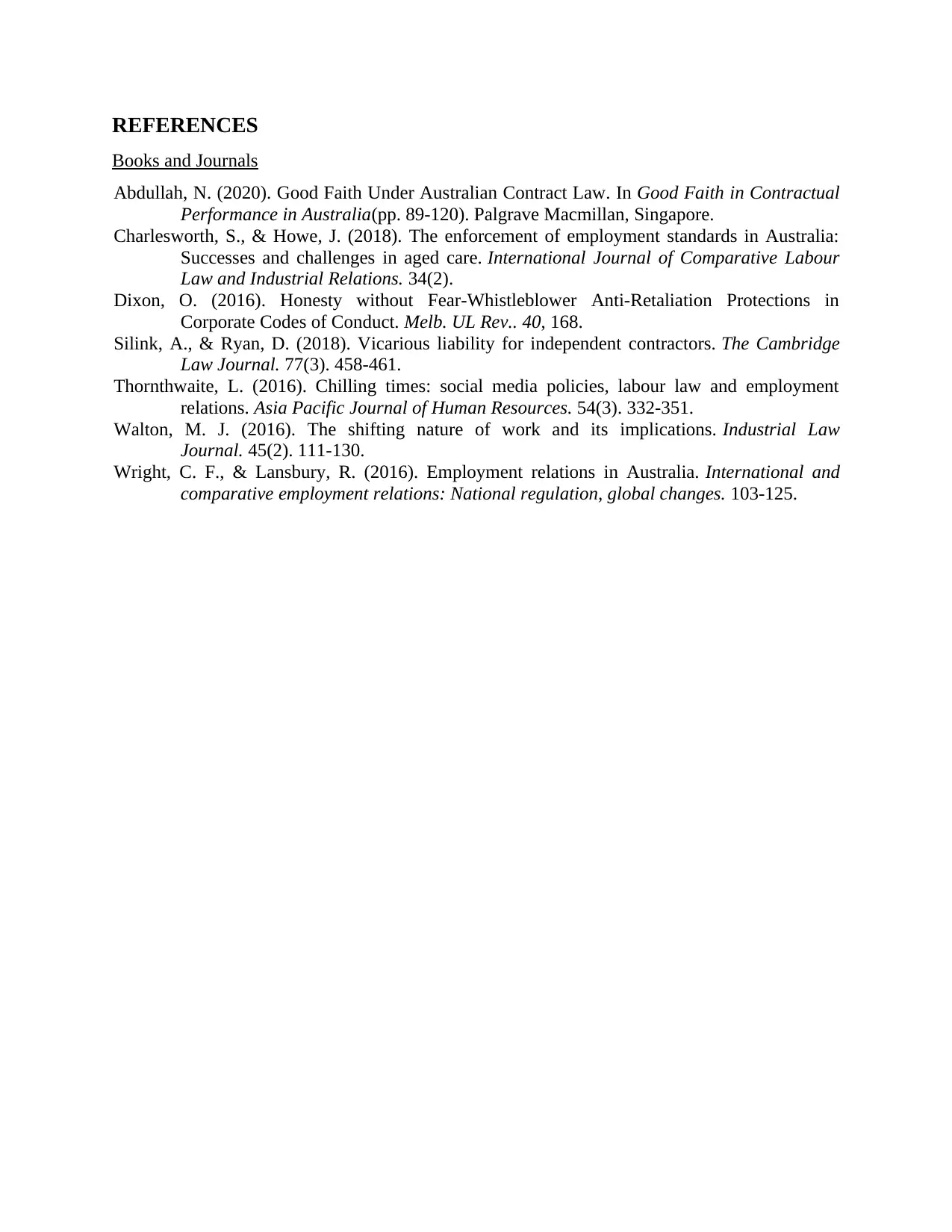
REFERENCES
Books and Journals
Abdullah, N. (2020). Good Faith Under Australian Contract Law. In Good Faith in Contractual
Performance in Australia(pp. 89-120). Palgrave Macmillan, Singapore.
Charlesworth, S., & Howe, J. (2018). The enforcement of employment standards in Australia:
Successes and challenges in aged care. International Journal of Comparative Labour
Law and Industrial Relations. 34(2).
Dixon, O. (2016). Honesty without Fear-Whistleblower Anti-Retaliation Protections in
Corporate Codes of Conduct. Melb. UL Rev.. 40, 168.
Silink, A., & Ryan, D. (2018). Vicarious liability for independent contractors. The Cambridge
Law Journal. 77(3). 458-461.
Thornthwaite, L. (2016). Chilling times: social media policies, labour law and employment
relations. Asia Pacific Journal of Human Resources. 54(3). 332-351.
Walton, M. J. (2016). The shifting nature of work and its implications. Industrial Law
Journal. 45(2). 111-130.
Wright, C. F., & Lansbury, R. (2016). Employment relations in Australia. International and
comparative employment relations: National regulation, global changes. 103-125.
Books and Journals
Abdullah, N. (2020). Good Faith Under Australian Contract Law. In Good Faith in Contractual
Performance in Australia(pp. 89-120). Palgrave Macmillan, Singapore.
Charlesworth, S., & Howe, J. (2018). The enforcement of employment standards in Australia:
Successes and challenges in aged care. International Journal of Comparative Labour
Law and Industrial Relations. 34(2).
Dixon, O. (2016). Honesty without Fear-Whistleblower Anti-Retaliation Protections in
Corporate Codes of Conduct. Melb. UL Rev.. 40, 168.
Silink, A., & Ryan, D. (2018). Vicarious liability for independent contractors. The Cambridge
Law Journal. 77(3). 458-461.
Thornthwaite, L. (2016). Chilling times: social media policies, labour law and employment
relations. Asia Pacific Journal of Human Resources. 54(3). 332-351.
Walton, M. J. (2016). The shifting nature of work and its implications. Industrial Law
Journal. 45(2). 111-130.
Wright, C. F., & Lansbury, R. (2016). Employment relations in Australia. International and
comparative employment relations: National regulation, global changes. 103-125.
1 out of 7
Related Documents
Your All-in-One AI-Powered Toolkit for Academic Success.
+13062052269
info@desklib.com
Available 24*7 on WhatsApp / Email
![[object Object]](/_next/static/media/star-bottom.7253800d.svg)
Unlock your academic potential
Copyright © 2020–2025 A2Z Services. All Rights Reserved. Developed and managed by ZUCOL.





